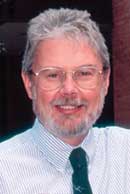From the Director
by Lee Allison,
Director and State Geologist

The KGS reputation for unbiased,
high-quality scientific
and technical analyses makes us perfectly and perhaps uniquely positioned
to
take on the challenges of running the energy council.
Over the past decade, the budget of the U.S. Geological Survey (USGS), the federal he KGS has long been engaged in research related to the state’s energy resources, but in the past year we’ve taken on additional responsibilities with the State Energy Resources Coordination Council (SERCC). As State Geologist, I have a permanent seat on the council, created by executive order in September 2002 under Governor Graves. I have served as chair of the council since its formation, and KGS editor Liz Brosius is serving as SERCC chief of staff with assistance from Scott White, in the KU Energy Research Center, based at the KGS.
The council produced its first comprehensive state energy plan in January 2003, less than four months after the council was formed. In August, the KGS published the Kansas Energy Abstract, a compilation of data about the state’s energy production, consumption, and historical and forecasted trends. On October 2, at the request of Governor Sebelius, the council sponsored the Kansas Summit on Natural Gas, to discuss natural gas price and supply issues and the impact on consumers.
SERCC was given the task of making Kansas energy self-sufficient and an energy exporter. The council subsequently adopted another goal: to help ensure Kansans have low-cost, reliable, and sustainable energy, produced in-state to the fullest extent possible. The council recognized that self-sufficiency alone might not be in the best economic interests of the state. Certainly more oil and gas would be produced from Kansas’s aging and declining fields if the price were higher, but that would likely slow economic growth in other areas of the economy.
The council’s first energy plan recognized three new energy resources with great potential: natural gas from coal seams (coalbed methane), ethanol, and wind. The natural gas and ethanol arenas are moving forward because the infrastructure exists to encourage private investment. For wind energy, however, there are some obstacles to development. Despite Kansas’s exceptional wind potential, environmental concerns (see cover story) and transmission limitations must be resolved if wind power is to generate a significant part of the state’s electricity.
One of the council’s top priorities was to set up a Transmission
Task Force to look at constraints in the electrical transmission system
that are holding back development of wind power. Some of the best areas
for wind energy are far from population centers that need the power, and
transmission lines don’t have the capacity to carry the power to
where it is needed. That Task Force is now in place and working on analyses
and recommendations for SERCC to consider.
The Task Force has a second assignment—to look at the reliability
and security of the electric grid in Kansas in the aftermath of the northeast
U.S. blackout in August.
The KGS reputation for unbiased, high-quality scientific and technical analyses makes us perfectly and perhaps uniquely positioned to take on the challenges of running the energy council.
The KGS fills a role as the state science agency without regulatory conflicts. As society needs more scientific advice, it is only logical to turn to an institution with over a century of science research and service to the state.
![]()
Online December 12, 2003
Comments to: lbrosius at kgs.ku.edu
Kansas Geological Survey
URL:http://www.kgs.ku.edu/Publications/GeoRecord/2003/vol9.3/Page2.html